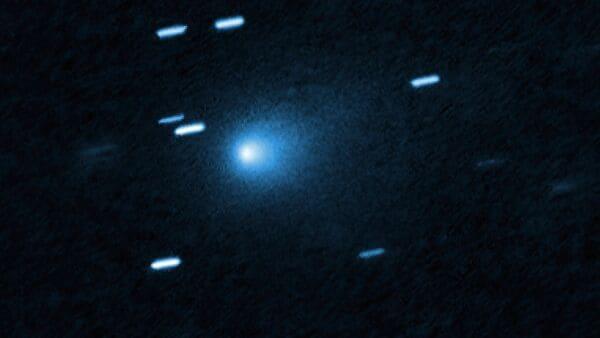
3I/ATLAS Interstellar Comet Glows Green In New Image, Astronomer Links It To Sunscreen
According to a Live Science report, Qicheng Zhang, a researcher at the Lowell Observatory in Arizona, used the observatory's powerful Discovery Telescope to make fresh observations of the interstellar comet as it zoomed away from the sun on Wednesday (November 5).
The comet recently became visible again after swinging around the far side of our star.
The green glowAs per the report, the researcher used a filter to detect diatomic carbon (C2) particles, which glow green.
He noted that there's a bunch of large molecules in the comet that contain carbon and hydrogen (hydrocarbons).
And when the comet gets close to the sun, ultraviolet (UV) light breaks these molecules apart.
"It's sort of for the same reason that if we stay out in the sun too long without sunscreen, we get sunburnt," Zhang told Live Science.
Qicheng Zhang used the Lowell Observatory to observe comet 3I/ATLAS in all of its green glory."The UV rays are destroying our DNA [in our skin cells], which is kind of a similar type of molecule in the sense that it's big and contains carbon."
When this happens on a comet, some of the molecule chunks are two carbon atoms stuck together, or diatomic carbon, which are easy for astronomers to detect.
Earlier, it was reported that the comet had changed colour upon getting close to the Sun. It turned a bright blue instead of the usual red.
3I/ATLAS's hidden tailThe comet appears to lack a dust tail in the image, but it's still there, Live Science reported.
Zhang told the media outlet that if we look closely at the image, one can see it's a bit brighter on the left side of the comet than on the right.
That slight asymmetric glow occurs because we're seeing the tail basically head-on, and it's right behind the comet, curving slightly off to the left.
In other words, the comet's apparent lack of tail isn't anything to get excited about.
What we know about Comet 3I/ATLASComet 3I/ATLAS has only recently become visible from Earth again after it briefly disappeared behind the sun, reaching its closest point to our star, known as perihelion, on Oct. 29.
This post-perihelion phase opens up a critical window for astronomers hoping to learn more about the comet's gases and makeup, as comets tend to be their most active at perihelion.
This comet, which NASA says came from outside our solar system, was discovered in July this year. The comet is only the third interstellar visitor ever recorded and could be the oldest comet ever seen, with one study suggesting it's around 3 billion years older than the solar system.
Legal Disclaimer:
MENAFN provides the
information “as is” without warranty of any kind. We do not accept
any responsibility or liability for the accuracy, content, images,
videos, licenses, completeness, legality, or reliability of the information
contained in this article. If you have any complaints or copyright
issues related to this article, kindly contact the provider above.


















Comments
No comment